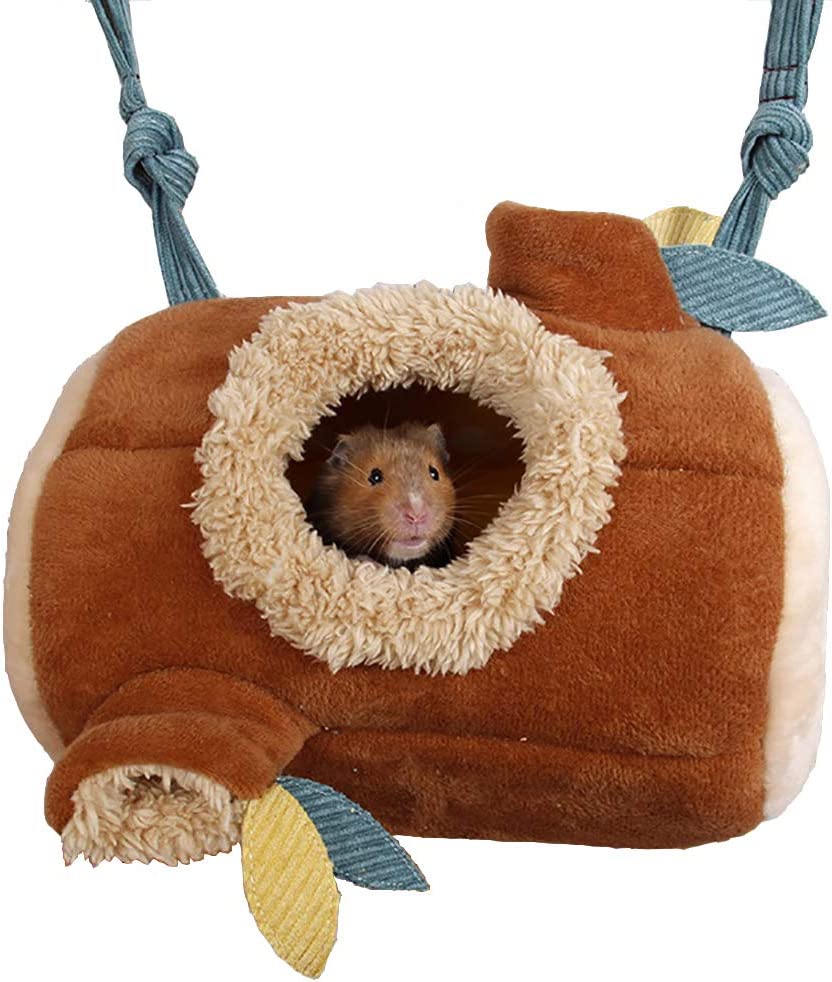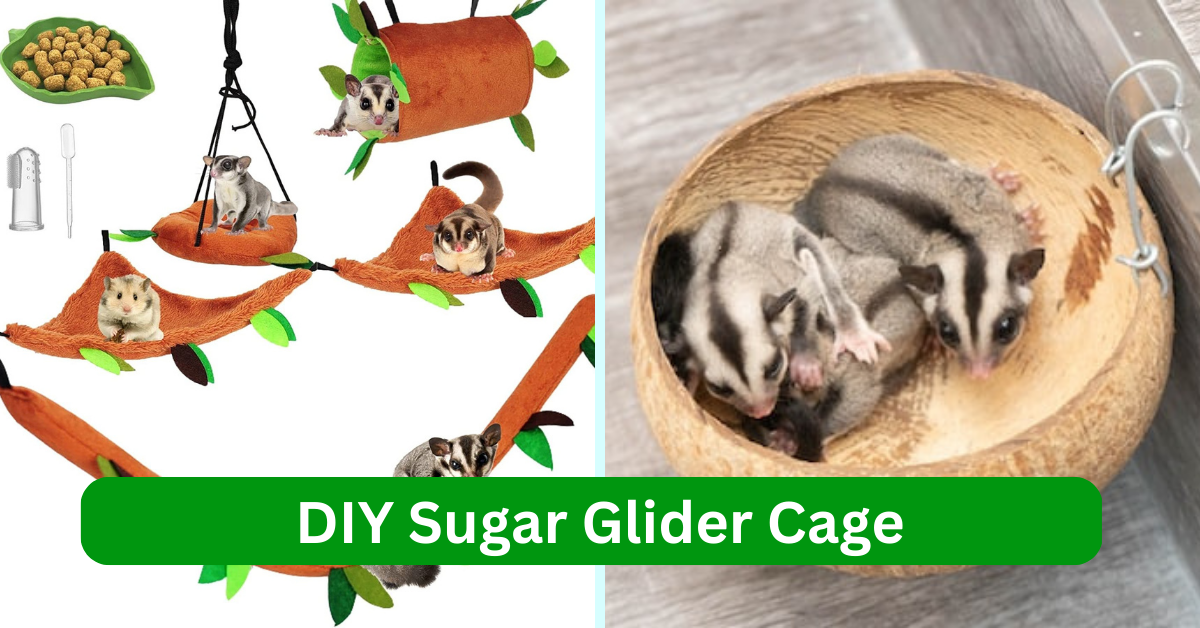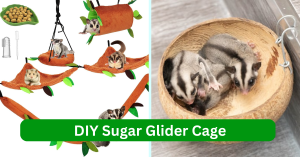There are certain considerations to make when creating a cage for sugar gliders. To begin with, the cage needs to be big enough to accommodate the sugar gliders’ innate climbing and jumping abilities. A reasonable starting point is a cage that is at least 2 feet wide, 2 feet deep, and 6 feet tall. For the sugar gliders to explore, the cage should also have branches and other climbing elements.
The cage’s construction material is yet another crucial factor. Because of their pointed claws, sugar gliders should be contained in a cage with a strong wire mesh to prevent escape. Additionally, it’s crucial to equip the door with a reliable latch or lock to keep the sugar gliders out. Additionally, it’s critical to check that the cage is built to keep sugar gliders secure and healthy. For instance, the cage needs to be out of the way of drafts and direct sunlight, and it needs to be cleaned frequently to avoid the growth of bacteria and parasites.
Before creating a DIY cage, it’s crucial to do some research and comprehend the particular requirements of sugar gliders. Additionally, it’s crucial to keep in mind that because sugar gliders are social creatures, it’s best to keep them in pairs or small groups rather than alone.
A PVC Sugar Glider Cage
Making a DIY PVC cage for sugar gliders can be an affordable way to provide them with a comfortable home. Creating a PVC cage for sugar gliders involves the following steps:
- Assemble the materials: a saw, a drill, PVC pipes, and PVC connectors are required.
- The PVC pipes should be measured and cut to the cage’s required size. The cage needs to be 6 feet tall, 2 feet wide, and 2 feet deep.
- Utilizing the PVC connectors, put together the cage frame. Verify the stability of the frame and the security of all connections.
- To fit the cage’s frame, cut a piece of wire mesh. By means of zip ties or a powerful adhesive, fasten the wire mesh to the frame.
- Include climbing elements in the cage, such as PVC pipe ladders or branches.
- Using a PVC connector and a hinge, attach a door to the cage. In order to stop the sugar gliders from fleeing, ensure that the door has a sturdy latch or lock.
- Place the cage in a secure area that is free from drafts and harsh sunlight.
- In order to avoid the growth of bacteria and parasites, clean the cage frequently.
Sugar Glider Cube
Sugar gliders can live in a cube cage, which gives them a small, safe living environment while still allowing them to jump and climb. A sugar glider cube cage can be made using the following instructions:
- A plastic storage cube, a saw, a drill, wire mesh, and a sturdy latch or lock for the door are required. Collect the components.
- The wire mesh should be measured and trimmed to fit the storage cube’s sides and top.
- With the aid of strong glue or zip ties, fasten the wire mesh to the storage cube. Ensure that the mesh is tight and that there are no openings that the sugar gliders could use to elude capture.
- Using a saw and a drill, cut a door into one of the storage cube’s sides. Ensure that the door is big enough for the sugar gliders to comfortably pass through.
- To keep the sugar gliders inside, install a secure latch or lock on the door.
- Include climbing aids inside the cage, like branches or ladders.
- Place the cage in a secure area that is free from drafts and harsh sunlight.
- In order to avoid the growth of bacteria and parasites, clean the cage frequently.
- Being gregarious creatures, sugar gliders should preferably be kept in couples or small groups and should never be kept alone. They should have enough room to play, move around, and climb inside the cube cage. To preserve the sugar gliders’ health and wellbeing, it’s also crucial to make sure they have access to fresh food and water, as well as that the cage is routinely cleaned.
- Before creating a cage for sugar gliders, it is best to seek advice from seasoned keepers or veterinarians.
DIY Wooden Sugar Glider Cage
Making a wooden cage for sugar gliders might be an excellent option because it gives them a safe and robust place to live and allows them to climb and jump. Here are the steps to building a sugar glider cage out of wood on your own:
- Assemble your supplies: You’ll need wire mesh, wood, a strong latch or lock for the door, a saw, a drill, a drill bit, and assembly components.
- The wood components should be measured and cut to the cage’s required size. The cage needs to be 6 feet tall, 2 feet wide, and 2 feet deep.
- Utilizing the hardware and wood parts, construct the cage frame. Verify the stability of the frame and the security of all connections.
- To fit the cage’s frame, cut a piece of wire mesh. Using hardware or a strong glue, fasten the wire mesh to the frame. Ensure that the mesh is tight and that there are no openings that the sugar gliders could use to elude capture.
- Use a saw and drill to cut a door into one of the cage’s sides. Ensure that the door is big enough for the sugar gliders to comfortably pass through.
- To keep the sugar gliders inside, install a secure latch or lock on the door.
- Include climbing aids inside the cage, such as wooden ladders or branches.
- Place the cage in a secure area that is free from drafts and harsh sunlight.
- In order to avoid the growth of bacteria and parasites, clean the cage frequently.
- The use of wood for sugar glider cages is not advised due to its propensity to absorb moisture and serve as a breeding ground for bacteria and parasites. If you choose to use wood, ensure that it is non-toxic and that the cage is frequently cleaned and sanitized.
- Since sugar gliders are arboreal creatures, a wooden cage should provide them with enough room to walk about, play, and climb. To preserve the sugar gliders’ health and wellbeing, it’s also crucial to make sure they have access to fresh food and water, as well as that the cage is routinely cleaned.
- Before creating a cage for sugar gliders, it is best to seek advice from seasoned keepers or veterinarians.
Wire Mesh Sugar Glider Cage
It can be a terrific idea to build a wire mesh cage for sugar gliders because it gives them a safe, long-lasting home and allows them to jump and climb. To create a wire mesh cage for sugar gliders at home, follow these steps:
- Collect the materials: You’ll need wire mesh, wire cutters, pliers, a reliable door latch or lock, and assembly components.
- The wire mesh should be measured and cut to the required cage size. The cage needs to be 6 feet tall, 2 feet wide, and 2 feet deep.
- Utilizing the wire mesh and hardware, assemble the cage frame. Verify the stability of the frame and the security of all connections.
- To make a door, cut a piece of wire mesh and fasten it to one side of the cage. Ensure that the door is big enough for the sugar gliders to comfortably pass through.
- To keep the sugar gliders inside, install a secure latch or lock on the door.
- Include climbing aids inside the cage, such as wood or PVC pipe ladders or branches.
- Place the cage in a secure area that is free from drafts and harsh sunlight.
- It’s vital to remember that wire mesh is not suggested for sugar glider cages because it can harm the animals’ paws and tails. If you choose to use wire mesh, make sure it is coated, non-toxic, and that the cage is frequently cleaned and sanitized.
- Because sugar gliders are arboreal creatures, a wire mesh cage should have enough room for them to walk about, play, and climb. To preserve the sugar gliders’ health and wellbeing, it’s also crucial to make sure they have access to fresh food and water, as well as that the cage is routinely cleaned.
- Before constructing a cage for a sugar glider, it is generally recommended that you speak with an expert.
- In order to avoid the growth of bacteria and parasites, clean the cage frequently.
Panel Sugar Glider Cage
It can be a terrific idea to build a panel cage for sugar gliders because it gives them a safe, sturdy home and allows them to jump and climb. Here are the procedures for building a sugar glider panel cage from scratch:
- In order to assemble the panel, you will need hardware: a strong latch or lock for the door, a saw, a drill, and panel material like PVC or plastic.
- The panel components should be measured and cut to the cage’s desired size. The cage needs to be 6 feet tall, 2 feet wide, and 2 feet deep.
- Utilizing the panel parts and hardware, assemble the cage frame. Verify the stability of the frame and the security of all connections.
- To make a door, cut a piece of panel material and fasten it to one side of the cage. Ensure that the door is big enough for the sugar gliders to comfortably pass through.
- To keep the sugar gliders inside, install a secure latch or lock on the door.
- Include climbing aids inside the cage, such as wood or PVC pipe ladders or branches.
- Place the cage in a secure area that is free from drafts and harsh sunlight.
- In order to avoid the growth of bacteria and parasites, clean the cage frequently.
- It’s crucial to remember that PVC and plastic are not suggested for sugar glider cages since they can damage the animals’ paws and tails. Make sure the panels are non-toxic and that the cage is frequently cleaned and sanitized if you choose to use PVC or plastic.
- Because sugar gliders are arboreal creatures, a panel cage should have enough room for them to walk around, play, and climb. To preserve the sugar gliders’ health and wellbeing, it’s also crucial to make sure they have access to fresh food and water, as well as that the cage is routinely cleaned.
- Before constructing a cage for a sugar glider, it is generally recommended that you speak with an expert.

Conclusion
To sum up, making a DIY cage for sugar gliders might be a wonderful alternative, but it’s crucial to make sure the cage is secure, safe, and appropriate for the animals’ requirements. The paws and tail of the sugar gliders could be injured by wire mesh and PVC or plastic materials; thus, they are not advised. For them to move around, play, and climb, there needs to be enough room. To preserve their health and well-being, it’s also crucial that they have access to fresh food and water, as well as that the cage is cleaned frequently. Before creating a cage for sugar gliders, it is best to seek advice from seasoned keepers or veterinarians.
FAQ Section
What is the ideal cage for a sugar glider?
It is advised to use a sizable cage with a strong lock that is at least 24 by 36 by 36 inches (61 by 91 by 91 cm) in size. In addition to having space for a food dish and a nest box or shelter where your pet can sleep during the day, the enclosure should also have ample space for exercise.
Can a sugar glider be kept in a bird cage?
Since they enjoy climbing and jumping, these creatures require climbing surfaces. Sugar glider cages greatly benefit from the installation of bird perches, which can be made of wood or plastic.
Do sugar gliders require a large space?
The cage for a sugar glider should be as big and tall as feasible. To climb, they require a lot of space. 20′′ x 20′′ x 30′′ are the suggested dimensions for one sugar glider. The bars or wire mesh in the cage should be spaced closely enough together to prevent your little glider from passing through.



